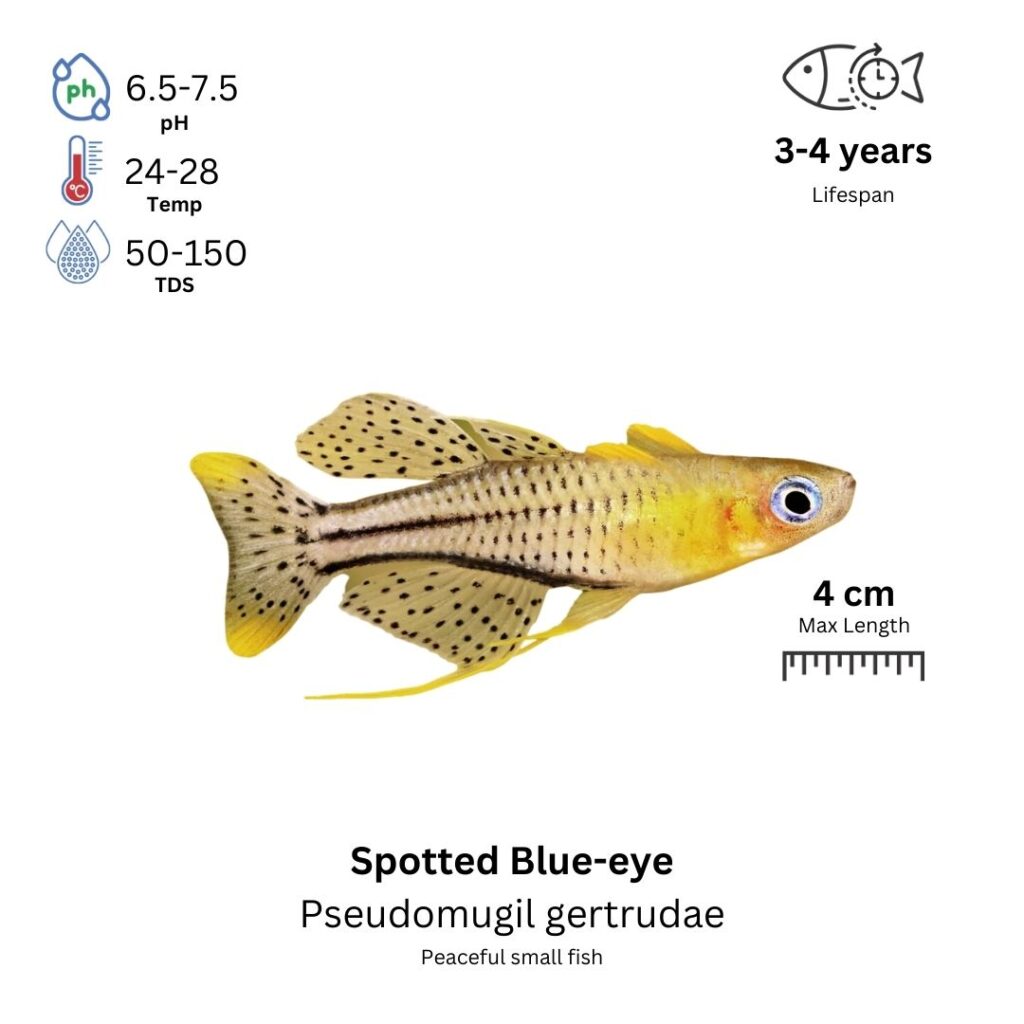Spotted Blue-eye
Pseudomugil gertrudae

Description
The Spotted Blue-eye is a small, striking species of rainbowfish known for its iridescent coloration and distinctive pattern of black spots on its body. The fish has a slender, elongated body with metallic blue hues that shimmer under proper lighting. The name “Spotted Blue-eye” comes from the characteristic black spots that appear along the body and especially on the tail and fins. These spots give the fish a dotted appearance, which contrasts beautifully with the blue and silver tones of the body. The males tend to have more vibrant coloration and more pronounced spots compared to the females, which are generally more subdued in color.
Habitat Origin
Native to the freshwater streams and rivers of Northern Australia and New Guinea. They inhabit slow-moving or still waters with clear, slightly acidic to neutral pH, and they are typically found in environments with dense vegetation and submerged structures like rocks and branches. In the wild, they prefer well-oxygenated, warm water that provides plenty of hiding spots and grazing opportunities.
Aquarium
Ideal Number in Aquarium: At least 6 individuals, as they are schooling fish and feel more secure in groups.
Favorite Food

Spotted Blue-eyes are omnivores and will accept a variety of foods. They can be fed high-quality flake food, micro pellets, and live or frozen foods such as brine shrimp, daphnia, and bloodworms. They will also graze on algae and small plant matter in the aquarium. A balanced diet is essential to maintain their vibrant coloration and overall health.
Behavior:
Spotted Blue-eyes are peaceful and social fish that do best in schools. They are active swimmers, often seen darting around the middle or upper regions of the aquarium. These fish are not territorial and generally get along well with other peaceful species. They may become shy or stressed if kept alone, so it is essential to keep them in schools of at least 6 individuals. Their peaceful nature makes them an excellent addition to a community tank with other small, non-aggressive species. They are also known for their gentle disposition and can coexist with shrimp and snails.
Special Care:
Spotted Blue-eyes are hardy but thrive best in stable water conditions. Regular water changes and good filtration are important for maintaining water quality. They prefer a well-planted aquarium with plenty of hiding spots, such as rocks, driftwood, and aquatic plants. Although they are not particularly demanding, providing a clean and well-oxygenated environment will help them remain healthy and vibrant. It is also important to avoid large, aggressive species that may intimidate or harm them.
Compatibility with Other Fish:
Yes, Spotted Blue-eyes are compatible with many other peaceful fish species. They can be housed with small tetras, rasboras, small cichlids, catfish, and other peaceful aquarium fish. They are also safe to keep with shrimp and snails. Larger, aggressive fish should be avoided, as they may stress or harm the Spotted Blue-eyes. These fish do best in a peaceful community aquarium with other small, non-aggressive species.
Breeding Tank Setup
Establishing a separate breeding tank is strongly recommended for Spotted Blue-eyes to effectively control water parameters and safeguard the eggs and fry from potential predation. A 40-liter (10-gallon) tank is ideal, offering adequate space for a breeding pair or small group and facilitating easy water maintenance. Optimal conditions include slightly acidic to neutral water (pH 6.5–7.5), temperatures between 24°C and 28°C (75°F–82°F), and soft to moderately hard water (5–12 dGH). Use gentle filtration systems such as sponge filters or low-flow internal filters to maintain water quality without creating stressful currents. Provide fine substrate like sand or smooth gravel, complemented by live plants like Java moss, Hornwort, and Anubias, along with floating plants such as duckweed, to mimic their natural environment and create shaded, secure spawning areas. Moderate lighting, replicating their naturally dim habitats, promotes natural spawning behaviors.
Conditioning for Breeding
Conditioning Spotted Blue-eyes for spawning involves offering a varied, high-protein diet to promote optimal health and reproductive readiness. Feed them high-quality flakes along with live foods like brine shrimp, daphnia, and bloodworms, supplemented by frozen options such as mysis shrimp. Regular small water changes (approximately 25% weekly) are essential to maintain clean, fresh conditions, stimulating breeding behaviors and ensuring overall fish health.
Spawning Process
Spotted Blue-eyes are egg-scattering fish, with males courting females through vibrant color displays, particularly the characteristic bright blue spots on their bodies. Females scatter approximately 20–50 sticky eggs onto tank surfaces, plants, or rocks, with males fertilizing them shortly thereafter. Immediately after spawning, remove the adult fish from the tank, as they do not exhibit parental care and are likely to consume their own eggs. Removing adults significantly improves the chances of successful egg hatching.
Fry Care
Eggs typically hatch within 24–48 hours, depending on the water temperature. Newly hatched fry initially rely on their yolk sacs and remain near their hatching sites until becoming free-swimming. Once the fry begin swimming actively, offer them small foods like infusoria, microscopic algae, or liquid fry foods. Within a few days, introduce baby brine shrimp or other microscopic live foods, gradually transitioning to finely crushed flakes or small pellets as they mature. Maintain excellent water quality with daily small water changes (around 10–15%), stable temperatures (24°C–28°C), and consistent monitoring of ammonia, nitrite, and nitrate levels to ensure healthy fry development.
Important Breeding Notes
Spotted Blue-eyes typically reach sexual maturity between 6 and 12 months of age. Ensuring they are fully mature before attempting breeding significantly increases success rates. Males are distinguished by slimmer bodies and more vivid colors, particularly the prominent blue spots displayed during courtship, while females tend to be larger, rounder, and paler, especially when carrying eggs. Minimizing stress is crucial; keep tank conditions calm and stable, avoid overcrowding, and exclude aggressive tankmates or sudden environmental fluctuations to encourage successful spawning and minimize egg loss.
